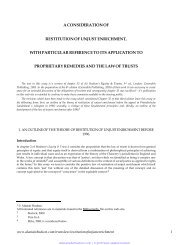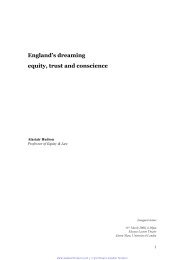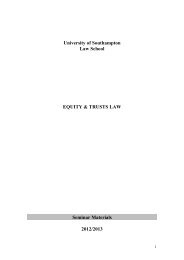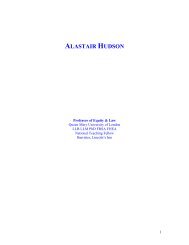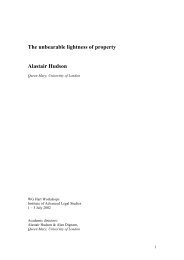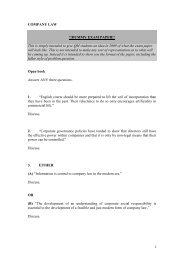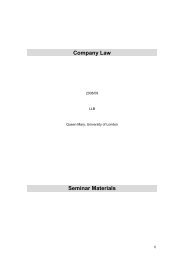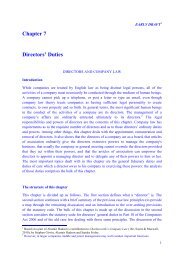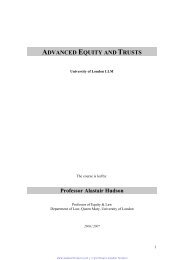The underpinning of my philosophy of teaching was best expressed ...
The underpinning of my philosophy of teaching was best expressed ...
The underpinning of my philosophy of teaching was best expressed ...
You also want an ePaper? Increase the reach of your titles
YUMPU automatically turns print PDFs into web optimized ePapers that Google loves.
Alastair HudsonQMULEnhancing the <strong>teaching</strong>- research nexusPublished research in law – whether in the form <strong>of</strong> student textbooks, practitionertreatises or journal articles – constitutes primary material if the research is cited incourt by judges, as <strong>my</strong> work has been, or if they genuinely conceptualise and orderthe existing case law and statutory principles. In this sense <strong>my</strong> published researchconstitutes a body <strong>of</strong> <strong>teaching</strong> materials. My student textbooks in particular havedeveloped novel ways <strong>of</strong> presenting material in <strong>my</strong> specialist fields, both in terms <strong>of</strong>accounts <strong>of</strong> technical concepts and also in terms <strong>of</strong> the <strong>teaching</strong> <strong>of</strong> self-reflectiveskills which I embed and undertake through these materials. On-line podcasts andessays then personalise skills <strong>teaching</strong> and advise on assessments withoutinterfering with pedagogic study.I take tremendous pr<strong>of</strong>essional pleasure in <strong>my</strong> research, whether it has been writtento teach law to students or to provide an analysis <strong>of</strong> for practitioners. Frequently,especially in the field <strong>of</strong> finance law, <strong>my</strong> research acts as a primary resource forscholars and practitioners in frontier areas where little has been written or decided bythe courts.<strong>The</strong> <strong>best</strong> example <strong>of</strong> this marriage <strong>of</strong> <strong>teaching</strong> and research is <strong>my</strong> textbook Equity &Trusts (5 th edition, Routledge-Cavendish, 2007). <strong>The</strong>re are a number <strong>of</strong> distinctivefeatures which I believe make this book more ‘student-friendly’ than others:the book is written with a controlled enthusiasm I do not discern in many otherlegal textbooks;it is written primarily to teach students rather than to impress otheracademics;each section begins with a summary <strong>of</strong> relevant principles before going on toanalyse these in depth. This means students know what principle they areseeking to study before they begin their reading. This acts as an ‘advancedorganiser’ which is essential to the successful study <strong>of</strong> law and encouragesdeep learning;each chapter has easy-to-understand, worked examples <strong>of</strong> legal principles,before then turning to the detail <strong>of</strong> the decided cases and statute. Again, byworking through hierarchical levels, students more easily develop coreunderstandings before seeing these worked through;the book advances a thesis <strong>of</strong> the nature <strong>of</strong> equity over its 1,200 pages (thusengaging with key pedagogic debates) as well as discussing the technicalmaterial which all trusts law courses require. This makes the book a bettercompanion over the course <strong>of</strong> a programme <strong>of</strong> study because it is constantlygiving a perspective on the technical material and so lifts the student out <strong>of</strong>the drudgery <strong>of</strong> note-taking;the book is interspersed with essays providing summations <strong>of</strong> severalchapters which tend to be studied separately by the typical student reader.Each essay is supported by free-to-air podcasts. <strong>The</strong> overall intention is toteach detailed concepts within an accessible theoretical framework. No otherbook in the field takes this approach.One review <strong>of</strong> the 3 rd edition <strong>of</strong> Equity & Trusts considered that:‘Any textbook on English law that quotes Aristotle and discusses chaostheory is likely to contain an interesting approach. Equity & Trusts does notdisappoint. … [it] takes a radically different approach from other books …Page 6 <strong>of</strong> 10



